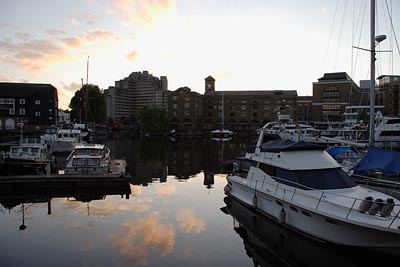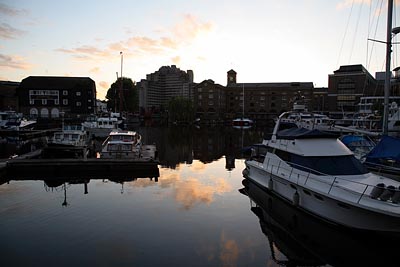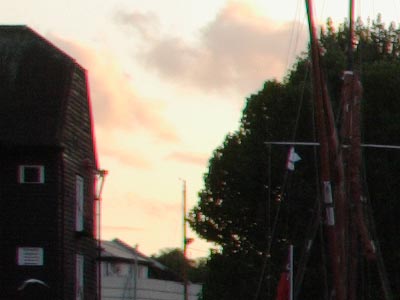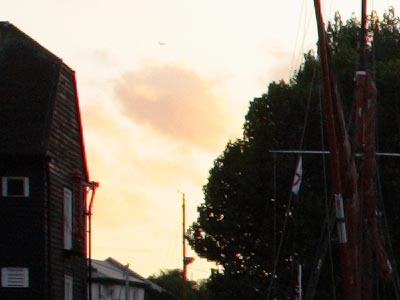EOS 5D and 24-105 f4L IS USM
v
EOS 20D and 17-85 f4-5.6 IS USM
PART 1 - First shots (23 September 2005) (Updated 29 September 2005)
Jump to:
Part 2 - More First Shots (Telephoto)
Part 3 - Noise
Part 4 - Same lens on both cameras - 200mm f2.8L Prime
Part 5 - Handling and differences
Part 6 - Dynamic Range, Conclusion and Links
I have held in my hands today possibly the "best" camera yet available to humanity. What I mean is that, given the choice to swap it for any other camera ever made, I would decline.
That is not to say, of course, that it has the best image quality of any camera. I have owned and sold cameras with higher image quality (Mamiya 7II for one). What I mean is that it is the most suited to my purpose, which is travelling relatively light whilst still delivering superb image quality in a variety of conditions at a wide range of focal lengths.
I am soon to go on a major round-the-world trip, and photography will be a significant part of it. A once-in-a-lifetime opportunity, for which naturally I want the best camera I can afford.
Before the EOS 5D was announced, I wrestled with the idea of "upgrading" from the 20D to an EOS 1Ds II but decided against it. The EOS 20D with its 17-85 IS lens is a brilliant travel camera and lens combination. Wide zoom range and image stabilisation together with the camera's low noise make for a very flexible but lightweight, compact and unobtrusive combination. An EOS 1Ds and 24-70 f2.8L would take better pictures, but at a significant cost. Compared with the 20D system, the 1Ds II with 24-70 would be about twice the size and weight with about half the zoom range and no IS. Potential street candid subjects would most likely run a mile at the sight of such an obvious "pro" camera.
I also considered taking the Mamiya 7II along with the EOS 20D. However I've always found two-camera systems, when the two cameras are strikingly different in operation, to be an equipment overload.
When the EOS 5D and 24-105 f4L IS were announced, buying both was a no-brainer. The lens should give significantly better results than the 17-85 but without sacrificing IS or much zoom range, and without being particularly enormous. The camera should be similar to the 20D but with a few more megapixels and a bigger viewfinder. This combination could replace the 20D and Mamiya 7II with a single camera. I had to have it!
I took delivery of the 5D and 24-105 lens today. This is not a pre-production test camera, but a full production camera, which I bought from a shop like everyone else. Excited as I was to see the results, I wasn't even expecting to be impressed by seeing the camera in the flesh. I knew it would look and handle just like the 20D. It does. Not so much like upgrading from a Golf to a Porsche, more like upgrading from a 1.6 litre Golf to a 2.0 litre Golf.
I practically ran home after work to start testing the new camera, as the light was failing (yes, I'm that sad!) I live near Tower Bridge in London so I rushed out to take a few comparison shots near the bridge just before sunset. My aim was to compare the cameras, whilst I still had access to both (I can't afford to keep the 20D). The photos are shot as test subjects, so apologies for their lack of artistic merit. Also, the cameras were on their own in this test - I wasn't going to be helping them out by using my knowledge. I know the 20D tends to overexpose quite badly in contrasty light, but for the purposes of this test the cameras would be left to their own devices. I was expecting the metering to be identical on both cameras, and it pretty much seemed to be.
Today I am testing camera and lens combinations. In the real world, the 20D plus 17-85 is a comparable system to the 5D plus 24-105L. If there was a 17-85L lens, I would probably have bought it for the 20D, but there isn't, so I'm testing what is available. As far as I'm concerned a large part of the point in "upgrading" to a 5D is to be able to use the 24-105L lens, which should be a significant step up from the 17-85. I will test both cameras with the same lens later.
If what you're really looking for is an academic and scientific comparison between the "crop-factor" sensor on the 20D and a full-frame sensor, I would highly recommend this article, which is (in my opinion) a rigorous, knowledgeable and unbiased comparison between the 20D, 1D mark II and 1Ds mark II sensors. My "review", by comparison, is simply a quick and dirty look at what I'm getting for my extra £1500 (the 5D and "L" lens combination costs, here in the UK, approximately twice as much as the 20D and 17-85).
|
|
|
|
Eos 20D 1/60th @ f8 400ASA |
Eos 5D 1/100th @ f8 400ASA |
Adobe Camera Raw won't yet convert the EOS 5D Raw files. Fortunately the Canon software which came with the camera will, but it's not as good as Adobe Camera Raw. In particular, unless I'm missing something, it doesn't have the (pretty much essential) feature to remove chromatic aberration. The EOS 5D is therefore immediately at an unfair disadvantage in this comparison. I could just compare JPEG files, but that would be crippling the results from both cameras. So I decided to level the playing field by converting Raw files from both cameras using the Canon software. The results from neither camera are at their best, therefore.
The two shots above show a scene in St Katherine Docks, taken at 17mm with the 20D (left) and 24mm with the 5D (right). As you can see, 24mm on the EOS 5D is slightly wider than 17mm on the 20D.
Doing a bit of "pixel peeping", at 100% magnification, when converted using the Canon software, huge and distracting chromatic aberrations are obvious on both the 20D/17-85mm and the 5D/24-105L combinations:
|
Eos 20D Eos 5D |
The 5D and "L" lens, as might be expected, is a little better, but the chromatic aberration is still fairly minging. Fortunately there is a solution. Or at least there will be when Adobe get around to including the 5D's Raw files amongst the capabilities of Adobe Camera Raw. By setting "fix red/cyan fringe" to "-70" in the "lens" tab of Adobe Camera Raw, the extract from the 20D on the left is corrected:
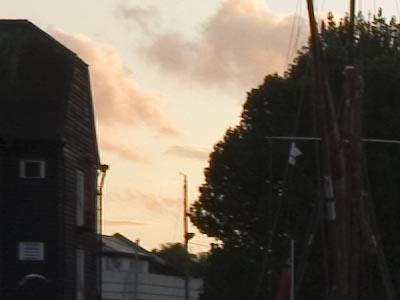
So far, the 5D and "L" lens combination is looking slightly superior but both systems are in the same ball park. Here's another example.
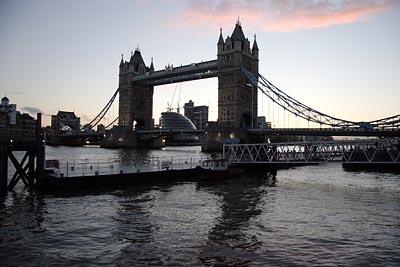
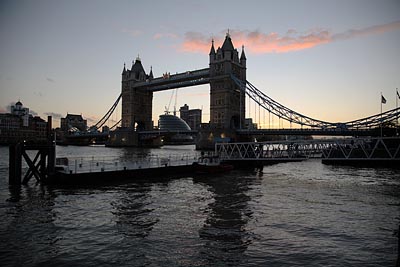 |
|
|
Eos 20D 1/125th @ f4 100ASA |
Eos 5D 1/100th @ f4 100ASA |
Again both cameras are at their widest setting. Again, the Eos 5D and 24-105L combination shows it's slightly wider. It also shows significantly more vignetting. Both shots were wide open at f4. I was expecting the "L" lens to shows its advantage wide open in comparison to the 17-85, but from a vignetting point of view the "consumer" grade 17-85 lens looks to have a slight edge.
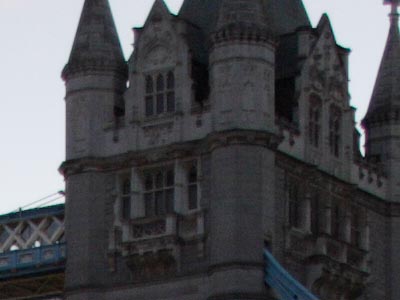
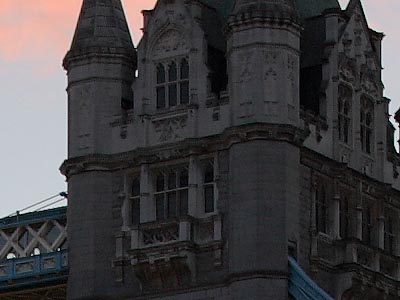 Eos 20D Eos 5D |
Near the centre of the photo, the 5D and "L" lens (right) shows significant superiority.
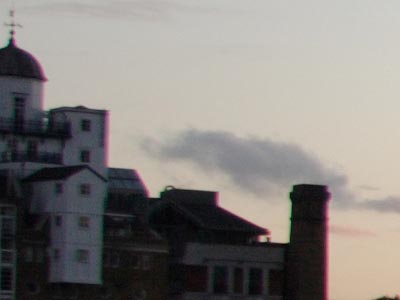
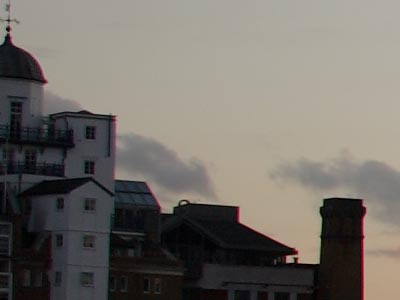 Eos 20D Eos 5D |
At the edge of the frame it's a similar story. Note both lens/sensor combinations show significant chromatic aberration, but this could be corrected in the Raw converter.
Update: over the last couple of days, I've taken a number more shots in better lighting conditions to make sure the results above were not a fluke. They are not.
